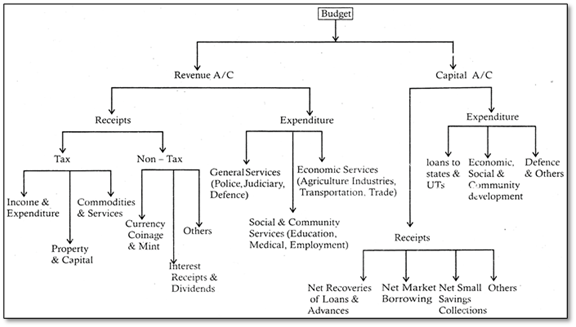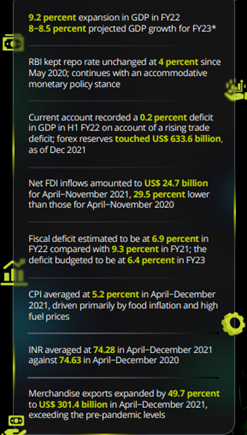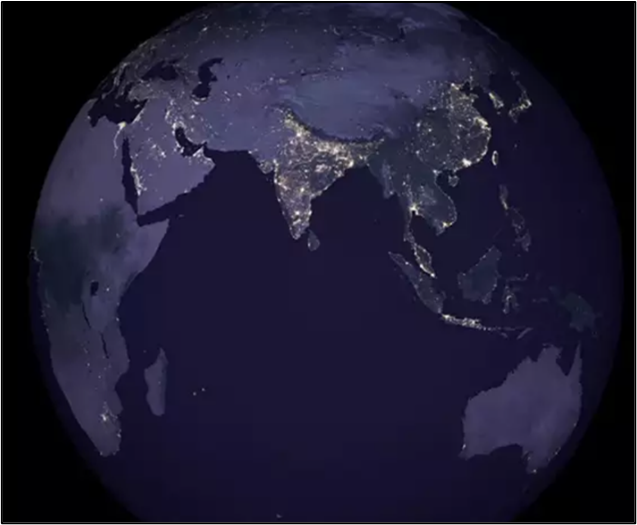Monday, 7th February 2022
Draft National Higher Education Qualification Framework
In News
The University Grants Commission (UGC) has recently developed a draft National Higher Educational Qualification Framework (NHEQF).
About the News
- Part of NEP 2020: The draft framework is a part of set of reforms envisaged by the National Education Policy (NEP) 2020.
- Diverse Domain: The new framework will encompass diverse domains such as job readiness, constitutional values, theoretical knowledge, technical skills etc and higher education institutes (HEIs) across the country will be brought under it to assess students on a range of learning outcomes.
- Objective: The framework does not intend to promote a uniform curriculum or national common syllabus but aims to elevate all HEIs to a common level of benchmarking to ensure that all institutions are providing quality education.
- Need for such Framework: India needs such a nationally accepted and internationally comparable qualifications framework in order to facilitate transparency and comparability of higher education qualifications at all levels given the size of its higher education system and the diversity of institutions and programmes of study.
- NHEQF envisages:
- The award of certificates, diplomas and degrees to students. This is based on what students completing a particular programme of study are “expected to know, understand and be able to do at the end of their programme of study.”
- It sets up certain parameters of assessments for students in higher education institutions and divided it in levels 5 to 10.
- Level 5 of the NHEQF represents learning outcomes appropriate to the first year of the UG programme of study and Level 10 represents learning outcomes with greater complexity appropriate to the doctoral-level programmes of study.
- Levels 1 to 4 cover the school education.
- At every level, the students will be assessed based on various parameters like knowledge and understanding of theory; cognitive and technical skills; application of knowledge and skills; decision-making abilities, constitutional, ethical and moral values etc.
- The draft also fixes the number of credits required to clear the different levels of the four-year undergraduate programme, master’s degrees and doctoral degrees.
National Education Policy 2020
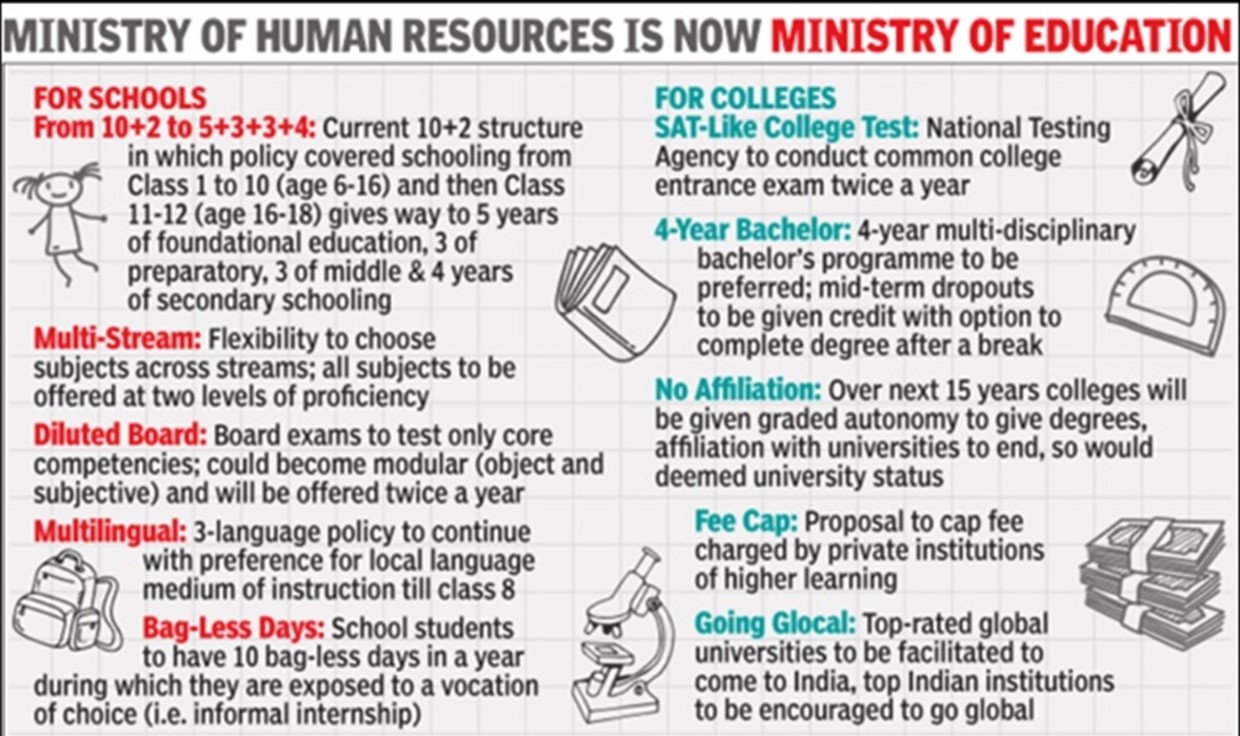
Source:
- UGC releases draft national higher education qualification framework
- UGC releases draft National Higher Educational Qualification Framework
Image source:
Import duty changes in Budget 2022
In News
The Union Budget has changed the trade tariffs on selected items in Budget 2022.
About the News
- Ministry of Finance has recently introduced a slew of higher custom duties on items of daily use including umbrellas, headphones, earphones, loudspeakers, smart meters, and imitation jewellery.
- It is perceived as a step to protect domestic industries which are not necessarily capital, technology or labour intensive and help enhance domestic value addition.
- Exemption are however being rationalised on implements and tools for agri-sector which are manufactured in India.
- India’s peak customs duty on non-agriculture products which had come down steeply from 150 per cent in 1991-92 to 40 per cent in 1997-98 and subsequently, to 20 per cent in 2004-05 and 10 per cent in 2007-08.
What are proposed changes in import duty?
- Hike in duty of items such as headphones and earphones to 20 per cent from 15 per cent, besides those on smart meters was raised to 25 per cent from 15 per cent.
- The concessional rate of customs duty on import of capital goods is proposed to be withdrawn in a phased manner. The Project Import Scheme providing concessional rates on specified projects will be available up till 10 September, 2022. Post-the expiry of the period, Basic Customs Duty will be paid at the rate of 7.5 percent. Further, customs duty exemptions on multiple products are withdrawn.
- Under Project Import Scheme, goods imported by a company are placed under a single tariff in the Customs Tariff Act, 1975 to facilitate faster assessment and clearances of goods.
- Duty on products such as methyl alcohol (methanol) and acetic acid has also been brought down to 2.5 per cent and 5 per cent, respectively from the existing 10 per cent.
- Reduction on customs duty on certain critical chemicals namely methanol, acetic acid and heavy feed stocks for petroleum refining.
- Increase in duty on sodium cyanide for which adequate domestic capacity exists.
- Customs duty exemptions to the steel scrap industry to provide relief to micro, small and medium-scale secondary steel producers.
Why the duty changes are important for India?
- China factor: Most of these products are imported from China, either as complete units or as knocked down units which are then assembled in factories in India.
- Saving domestic industry: Over the last five years, import duty hikes have been made on several occasions such as almonds, apples, and others. Other items such as cell phone parts and solar panels have seen the most regular hikes, with an aim to protect and nurture the domestic industry
- Vocal for local: One station-one product as a concept aims to promote a local product from each stop of the Indian Railways by making the railway station of that area a promotional and sales hub for the product.
- Duty concessions: Project import duty concessions have deprived the local producers of a level playing field in areas like coal mining projects, power generation, transmission or distribution projects, railway and metro projects.
- Need for calibrated tariffs: Reasonable tariffs are conducive to the growth of domestic industry and ‘Make in India’ without significantly impacting the cost of essential imports.
Sources:
The DLI scheme
In News
India has invited applications from 100 domestic companies, startups and SMEs to become a part of the Design-Linked Incentive (DLI) scheme.
About the News
- The sudden surge in demand of chips and semiconductor components globally, has underpinned the need to establish a robust semiconductor ecosystem in India.
- S., Japan, South Korea, Taiwan, Israel and the Netherlands that produce up to 70% of the world’s semiconductors.
- To absorb this uncertainty, schemes like the DLI are crucial that helps avoiding high dependencies on a few countries or companies as the scheme attracts the existing and global players by supporting their expenditures related to design software, IP rights, development, testing and deployment.
About the DLI scheme
- Provides Financial Infrastructure: The DLI scheme aims to provide financial and infrastructural support to companies setting up fabs (microchip manufacturing plants) or semiconductor making plants in India.
- It offers fiscal support of up to 50% of the total cost to eligible participants who can set up these fabs in the country.
- It also offers fiscal support of 30% of the capital expenditure to participants for building compound semiconductors, silicon photonics and sensors fabrication plants in India.
- It provides an incentive of 4% to 6% on net sales to companies of semiconductor design for integrated circuits, chipsets, system on chips, systems and IP cores for five years.
- Significance of the Scheme: This will boost the domestic companies, start-ups, and MSMEs to develop and deploy the semiconductor design.
- It will also help global investors to choose India as their preferred investment
- The scheme would facilitate the growth of at least 20 such companies which can achieve a turnover of more than ₹1500 crore in the next five years.
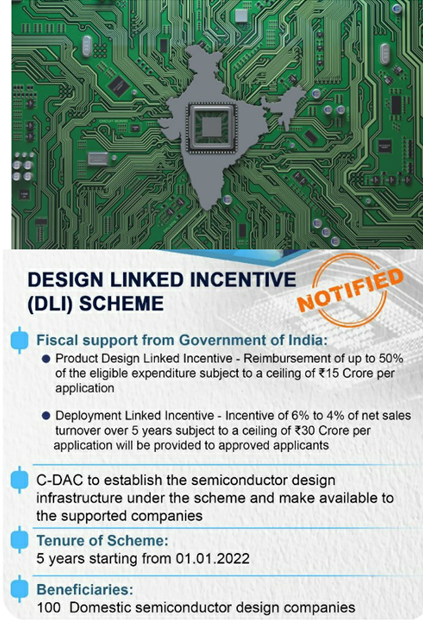
Prospects of Semiconductor Sector Growth in India
- Availability of Essential Inputs: Essential gases and minerals which are a part of the global semiconductor supply chain are produced in India.
- Skilled Workforce: Highly skilled engineering workforce for semiconductor manufacturing is available in India.
- Rapid Growth Trajectory: As the semiconductor industry is growing fast and is expected to reach $1 trillion dollar in a decade’s time, India can grow rapidly and reach $64 billion by 2026 from $27 billion today.
- Boosting segments of the sector: Mobiles, wearables, IT and industrial components are the leading segments in the Indian semiconductor industry that have contributed around 80% of the revenues in 2021 and is expected to multiply manifold.
Challenges in making semiconductors in India
- Lack of Proper fabrication units: In India, though more than 90% of global companies already have their R&D and design centres for semiconductors, there are no fabrication units established by these firms.
- Very selective Application: Despite semiconductor fabs established in various locations like Mohali and Bangalore, they are purely strategic for defence and space applications and not pan industrial in application.
- Capital Intensive Sector: Setting up fabs is capital intensive and needs large scale investment. This is complemented by lack of investments and supportive government policies.
- Geopolitics Dependent: New fabs use sub 5 nano meter technology that requires clearance from both the technology provider and the Government. Thus, the sector depends on a combination of capital and the geopolitical factors and conditions.
- Lack of Infrastructure: Insufficient infrastructure like connectivity to airports, seaports and availability of gallons of pure water are challenges in setting up fabs in India.
Source:
Picture source:
Ramabai Bhimrao Ambedkar
On February 7, 1898, Ramabai Bhimrao Ambedkar was the wife of Dr BR Ambedkar was born. Born in a poor Dalit family, Ramabai was the second daughter of Bhiku Dhatre Valangkar, a fish labourer near Dabjol and Rukmini. She was also known as Ramai or Mother Rama. She had a huge impact on Babasaheb Ambedkar’s life and was instrumental in helping him pursue higher education abroad. Ramabai Ambedkar passed away after a prolonged illness on 26 May, 1935. She had been married to Ambedkar for a period of 29 years. In 1941, on the launch of his book Thoughts on Pakistan, Ambedkar acknowledged the impact she had on his life, dedicating the book to Ramabai Ambedkar.
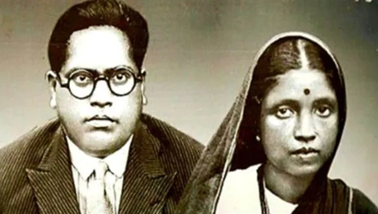
Source:
Inter-linking of Rivers
In News
The Union Budget has finalised five river linking projects.
About the News
- The Union budget has allocated Rs 44,605 crore for the implementation of Ken-Betwa river link project for irrigation of Bundelkhand region, a drought-prone region spreading across 13 districts of Uttar Pradesh and Madhya Pradesh.
- The Ken-Betwa River Interlinking (KBRIL) Project aims to transfer surplus water from the Ken to the Betwa to irrigate the drought-prone Bundelkhand region. Both, the Ken and Betwa are the tributaries of the Yamuna.
- The KBLP is the first under the National Perspective Plan (NPP) for the interlinking of rivers, which was prepared in 1980.
- The draft detailed project report of five river links, namely Damanganga-Pinjal, Par-Tapi-Narmada, Godavari-Krishna, Krishna-Pennar, and Pennar-Cauvery have been finalized.
- Once a consensus is reached among the beneficiary states, the Centre will provide support for implementation.
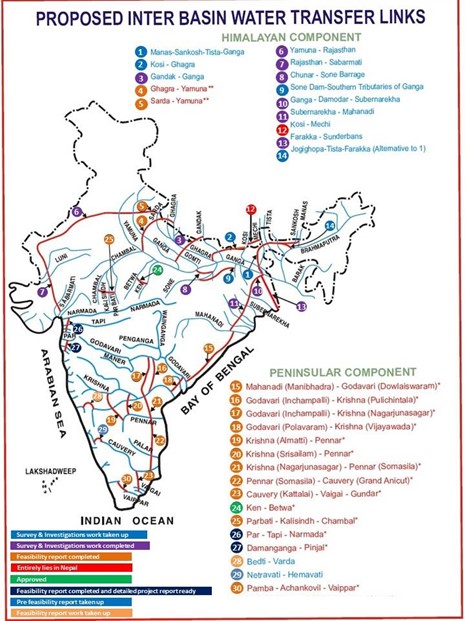
About the River-linking Project
- The National River Linking Project (NRLP) formally known as the National Perspective Plan, envisages the transfer of water from water ‘surplus’ basins where there is flooding to water ‘deficit’ basins where there is drought/scarcity, through inter-basin water transfer projects.
- Digging further into the term 'surplus' as per the Government, states that it is the extra water available in a river after it meets the humans’ requirement of irrigation, domestic consumption and industries.
- The National River Interlinking Project will comprise of 30 links to connect 37 rivers across the nation through a network of nearly 3000 storage dams to form a gigantic South Asian Water Grid. It includes two components:
- Himalayan Rivers Development Component under which 14 links have been identified. This component aims to construct storage reservoirs on the Ganga and Brahmaputra rivers, as well as their tributaries in India and Nepal. The aim is to conserve monsoon flows for irrigation and hydropower generation, along with flood control. The linkage will transfer surplus flows of the Kosi, Gandak and Ghagra to the west. A link between the Ganga and Yamuna is also proposed to transfer the surplus water to drought-prone areas of Haryana, Rajasthan and Gujarat.
- Peninsular Rivers Development Component or the Southern Water Grid, which includes 16 links that propose to connect the rivers of South India. It envisages linking the Mahanadi and Godavari to feed the Krishna, Pennar, Cauvery, and Vaigai rivers. This linkage will require several large dams and major canals to be constructed. Besides this, the Ken river will also be linked to the Betwa, Parbati, Kalisindh, and Chambal rivers.
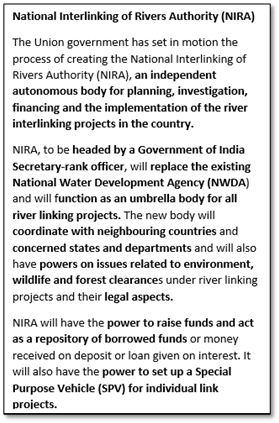
Why is the River-Linking Project important?
- Hydropower generation: The river interlinking project claims to generate total power of 34,000 MW (34 GW). Out of this, 4,000 MW will come from the peninsular component while 30,000 MW from the Himalayan component.
- Solution to Water Deficits: The Project is expected to curb the drinking water woes of millions and supply water to industries in drought-prone and water-scarce cities in south and west India.
- Irrigation benefits: The project claims to provide additional irrigation to 35 million hectares (m ha) in the water-scarce western and peninsular regions, which includes 25 m ha through surface irrigation and 10 m ha through groundwater.
- Economic Benefits: Irrigation Benefits will further create employment, boost crop outputs and farm incomes and multiply benefits through backward (farm equipment and input supplies) and forward linkages (agro-processing industries).
- Means for Inland Waterways: The project is expected to create several benefits for navigation, which is a cleaner means of transport, aiding the green footprint.
- Effective Utilization of Monsoon water: Annual rain fall of only around four month and uneven distribution of rainfall across India, indicates the need for effective sharing of rainfall water through inter-linked rivers.
What are the concerns being raised w.r.t. the project?
- Surplus and Deficit Definition: Experts refute the core basis of the project, which terms the river either 'surplus' or 'deficit'. The proposal is based on the serious ecological myth that river waters which drain into the sea, are going ‘waste’. There is no scientific basis to arrive at the conclusion that any river basin is surplus or deficit, since we have not done full assessment or implementation of options in any river basin or even a sub basin.
- The term 'deficit' has also been viewed in terms of humans only and not from the river's perspective, which includes many other factors.
- Submergence of Places: The Ken-Betwa inter-linking project would submerge a major portion of the core area of the Panna Tiger Reserve in Madhya Pradesh. The project will also lead to the loss of two million trees.
- A single Tehri dam was developed at the cost of total submergence of Tehri town and 40 villages and partial submergence of 72 other.
- Destruction of Ecological Processes: When rivers wind through forested, cultivated, and settled lands, they carry with them large amounts of silt. This silt is deposited along the way and is the basis of the rich agriculture of the plains of India, and of the rich fisheries off our coasts.
- The river also pushes out the sea, which would otherwise invade deep into the land, and erode the coast.
- Water Conflicts: The project could also create many water conflicts both at the state and international level. The country is already reeling due to many inter-state water conflicts.
- At the international level also, India is at crossroads with Pakistan over the sharing of the Indus' water, with Bangladesh over the Teesta's water, with China over the Brahmaputra's water and with Nepal over the Mahakali's water.
- Environmental Clearances bypassed: Although the project needs environment clearance, wildlife clearance and Supreme Court permission since it involves the diversion of land within a protected area of the tiger reserve, the Water Ministry has sought none.
- Social and Human Cost: No estimates exist of the number of people who will be so affected by the river linking project. There is no plan as how will these people be rehabilitated and what alternative land would be used to resettle them.
- Rivers with same Regime being linked: Regimes of river pairs like Ken-Betwa and Godavari-Krishna are almost same as they receive rainfall at same time and flow through similar region. Thus if one is dry or flooded then at the same time other will also be.
Way Forward
- There are a number of cheaper, socially and environmentally-benign options available to us, which can result in even larger benefits than a grand project. These include increasing irrigation and project-specific efficiency, rational cropping patterns, putting to use our existing mega infrastructure which is under-performing, using water equitably, harvesting rainwater and managing demand better, among others.
- Inter-linking of rivers initially appears to be a costly proposition in ecological, geological, hydrological and economical terms, in the long run the net benefits coming from it will far outweigh these costs or losses. But, first we should exhaust all options and potentials before concluding that river-linking is the best alternative.
Question: The River linking project comes with its benefits and concern. Elaborate
Source:
- Budget 2022: Rs 1,400 crore for Ken-Betwa river-linking, DPR finalised for five others:
- National River Linking Project: Dream or disaster?:
- Union Budget 2022-23: Activists express disbelief at sanction of money for river interlinking:
- Centre proposes setting up new body for river-linking projects in India:Budget 2022: What Are Ken-Betwa And Five River Linking Projects And What is Its Significance | Explained:
9.9 Crore-year-old Perfectly Preserved Flowers
This is image of 9.9 Crore-year-old flowers Perfectly Preserved in globs of amber in Myanmar. The flowers once bloomed at the feet of dinosaurs and that some flowers in Africa have remained unchanged for millions of years. Reportedly, these types of dinosaur-era amber fossils are extremely rare as they are only found in northern Myanmar’s Kachin State. The discovery becomes precious as flowers are considered ephemeral which means that they first bloom, transform into a fruit and then disappear. Due to this, there isn’t much data available on the ancient flowers in the fossil records. The findings would shed some light on Darwin’s “abominable mystery”. The mystery which had puzzled Darwin, is related to the sudden appearance of flowering plants in the fossil record in the Cretaceous period where no ancestral lineage from the earlier geological period.

Source:
Sattras
- Context: The Assam government has recently carried out eviction process of families encroaching the Sattra land.
- Sattras are monastic institutions of the neo-Vaishnavite tradition started by Vaishnavite saint-reformer Srimanta Sankaradeva.
- The neo-Vaishnavite tradition is a strand of the Bhakti movement and it began in Assam as a religious and social reform movement in the 15th and 16th centuries.
- The movement has been called the ‘cultural renaissance’ of Assam as it ushered in the development of new genres of music, dance and folk theatre.
- The devotees, known as bhakats, gathered at the sattras to offer prayers and perform before the almighty.
- Thus the sattras served as socio-religious and cultural centres in Assam.
- Over the years, there have been allegations of “encroachment” and “land grabbing” of Sattra land by suspected immigrant population which has led to the recent eviction process by the government.

Source:
Image source:
Pola Vatta
- Context: The Central Marine Fisheries Research Institute (CMFRI) has identified a new carangid (Vatta) species from the Indian coast.
- The new species belongs to the ‘queen fish’ group and is named as ‘Scomberoides pelagicus’ and in local parlance, the fish is known as ‘pola vatta’
- The fish is distinct by its deep ovate body, concave dorsal head profile, and stout and less numerous gill rakers on the first gill arch compared to the closely related species.
- It is available across the Indian coastline and is a highly relished and has good demand in the domestic market.
- The pola vatta species is the fifth queen fish from the Indian waters (the remaining 4 are the ‘queen fishes’ of the total 60 species of carangids in the Indian seas).
- Due to increased threat of depletion due to human consumption, three queen species have gone extinct.

Source:
- Kochi: CMFRI identifies new fish in Indian Waters
- New fish, 'pola vatta' in local parlance, identified from Indian waters
Image source:
India’s first Graphene Innovation Centre
- Context: The Kerala government has recently announced the country’s first Graphene Innovation Centre.
- The Centre for Graphene will come up in Thrissur district of Kerala, at a cost of Rs 86.41 crore.
- The project would be a major boost for scientific research as well as the state’s industrial sector.
- It is a joint venture of Digital University of Kerala, Centre for Materials for Electronics Technology (C-MET) and Tata Steel Limited.
- Graphene is a one-atom-thick layer of carbon atoms arranged in a hexagonal lattice.
- It is the building-block of Graphite, and has diverse properties.
- It is the thinnest, most electrically and thermally conductive material in the world. It is flexible, transparent and incredibly strong.
- Graphene is also known as “a wonder material” due to its vast potential in the energy and medical world.

Source:
- India’s first Graphene Innovation Centre to come up in Kerala
- India’s first graphene innovation centre to come up in Kerala
Image source:
‘Z' category security
- Context: Hyderabad MP has recently been given Z-category security after a recent attack.
- The Central Reserve Police Force (CRPF) and the Central Industrial Security Force (CISF) are the two forces tasked with providing securities to VIPs.
- The ministers get central security cover due to their position in the Government, and for private individuals, a call on such security is taken by the Home Ministry based on the inputs from the Intelligence agencies.
- There are 6 kinds of Central security covers: X, Y, Y+, Z, Z plus and Special Protection Group (SPG).
- While SPG protects only the Prime Minister, the other categories can be provided to anyone based on the Centre’s assessment.
- X category: 2 personal security officers round the clock, which is around 6 PSOs assuming an 8-hour shift.
- Y category: 2 PSOs and an armed guard at residence round the clock and additional security at night.
- Z category: CRPF commandos will be deployed for an individual’s security 24X7. About 16-20 armed commandos will be deployed in shifts and the person will also be provided with an escort and a pilot vehicle when he/she travels by road.
- Z+ category: In addition to z category security arrangements, protectees get a bulletproof car, escort in three shifts and additional security when required.
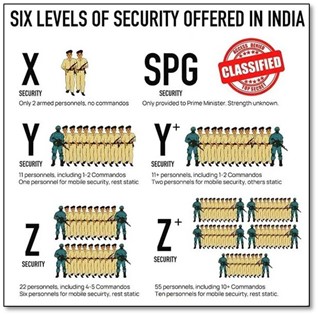
Source:
Picture source:
Space race: Outlining space strategies: ORF
Essence: The editorial focuses its agenda on the trend of research on dual use technology in space by major and emerging powers around the world. China, Russia, and USA have major capabilities in space domain like electronic and cyber warfare, directed energy weapons, co-orbital satellites and direct ascent missiles. One one hand, some of these technologies could be used for evasive maneuvers and clear space debris, while on the other, they possess potent weapon which could devastate opponent’s space missions.
Britain and India are relatively new entrants in space defense domain but have oriented themselves similar to the superpowers. Space defense strategy, private participation, collaboration for dual use research are high on agenda. Countries have converged their resources to deliver navigation, resource mapping, GIS, intelligence gathering and surveillance through space technologies.
Why you should read this article?
- To understand the direction of space technology prowess.
- To know the latest offerings countries especially China and USA in space capabilities.
Source:
How to create a better power distribution network: IE
Essence: In a bid to reform the power distribution sector, central government has launched the Revamped Distribution Sector Reform Scheme (RDSS). It aims for better feeder and transformer metering, pre-paid smart consumer metering and power loss reduction. Author points out that despite all its promises, just like earlier initiatives, RDSS also suffers from design issues like Complex process and lack of regulatory oversight in states.
To enable RDSS to play a significant role in increasing access and improving performance, it is important that all stakeholders i.e discoms, central and state government agencies and consumers play an active role.
Why should you read this article?
- To understand problems responsible for mediocre performance of power distribution sector.
- To understand some of the suggestions forwarded by experts which can improve the performance of the sector and increase access to power.
- To know about the features of Revamped Distribution Sector Reform Scheme (RDSS) and challenges it may face.
Source:
Self-regulatory regimes are key in digital businesses: HT
Essence: According to the author, there is unprecedented growth in the Online Curated Content (OCC) sector. This calls for regulation by the government to ensure fair markets and ethical standards to protect citizens. But the problem with government regulation is that it is slow and remains unchanged for years. This would be a challenge to keep pace with the rapidly changing OCC sector as it would be a burden to modify these regulations and need expertise.
As per the author, the concept of self-regulatory mechanisms is more apt for technology driven sectors. It would reduce the burden on courts and regulatory authorities by providing an alternative for grievance redressal and would build public trust for their commitment to the laws of the land.
The Information Technology (IT) rules, 2021 lay out a three-tier grievance redressal mechanism. At first to lodge an objection with an OCC platform and then escalate the complaint to an independent self-regulatory body. According to the Minister of Information and Broadcasting, 95% of the complaints received are being resolved at level I itself. Thus, self-regulation is working in the OCC sector and this model of self-regulation can serve as a model for the regulation of newer and emerging industries.
Why you should read this article?
- To know about the evolution of regulatory framework in India since independence.
- To understand the challenges in government driven regulation of technology driven sectors.
- To understand the advantages of the self-regulatory mechanisms.
- To know about the new IT Rules and their functioning.
Source:
Women to be the new workforce
Background
UNEP has initiated a program by partnering with a private company and NGO for training women from the informal sector of Gujarat to work in the modern clean energy industry.

About the Initiative
- Women workforce of Gujarat will be the targeted beneficiaries of the training and upgradation activities.
- This initiative will specifically work towards training the salt pan workers from Rann of Kutch as solar panel and solar pump technicians as part of India’s clean energy transition efforts.
- It will help leapfrog from the traditional energy sources to the renewable and clean energy and also create livelihood opportunities.
- After the success of the programme, the same will be replicated in different parts of the country as well.
- This will also lead to the achievement in the Sustainable Development Goals.
- The UNEP said this plan aims to expand the initiative over the next few years and sees potential to unlock global climate funds for similar developmental, green skill, green job and green entrepreneurship activities.
Quote: "Women, like men, should try to do the impossible. And when they fail, their failure should be a challenge to others” - Amelia Earhar"
Source:
Image Source:
Share the article
Get Latest Updates on Offers, Event dates, and free Mentorship sessions.

Get in touch with our Expert Academic Counsellors 👋
FAQs
UPSC Daily Current Affairs focuses on learning current events on a daily basis. An aspirant needs to study regular and updated information about current events, news, and relevant topics that are important for UPSC aspirants. It covers national and international affairs, government policies, socio-economic issues, science and technology advancements, and more.
UPSC Daily Current Affairs provides aspirants with a concise and comprehensive overview of the latest happenings and developments across various fields. It helps aspirants stay updated with current affairs and provides them with valuable insights and analysis, which are essential for answering questions in the UPSC examinations. It enhances their knowledge, analytical skills, and ability to connect current affairs with the UPSC syllabus.
UPSC Daily Current Affairs covers a wide range of topics, including politics, economics, science and technology, environment, social issues, governance, international relations, and more. It offers news summaries, in-depth analyses, editorials, opinion pieces, and relevant study materials. It also provides practice questions and quizzes to help aspirants test their understanding of current affairs.
Edukemy's UPSC Daily Current Affairs can be accessed through:
- UPSC Daily Current Affairs can be accessed through Current Affairs tab at the top of the Main Page of Edukemy.
- Edukemy Mobile app: The Daily Current Affairs can also be access through Edukemy Mobile App.
- Social media: Follow Edukemy’s official social media accounts or pages that provide UPSC Daily Current Affairs updates, including Facebook, Twitter, or Telegram channels.


